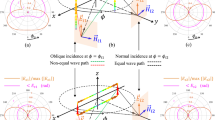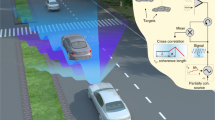Abstract
We derive the statistics of a coherently detected backscatter waveform taking into account the effects of polarization. For the first time these statistics are related to measurable parameters. We show that for long-range OTDRs the effects of polarization are statistically small.
In relation to the demodulation process we used our statistical model to show that for long-range operation and with heterodyne detection all types of demodulation provide similar performance. With homodyne detection half-wave demodulation results in a 7 dB lower signal-to-noise ratio than the other types of demodulation which have similar performance. There is the usual 3 dB advantage of homodyne over heterodyne detection. Our results indicate that with the same launched powers, the signal obtained from a coherent OTDR can have up to a 37 dB better signal-to-noise ratio than one obtained from an incoherent pulse OTDR. This results in a 9 dB range advantage.
We verify previously tabulated results which we found apply only for short-range operation. We use our model to predict the limits of long-range performance and to predict the effect of speckle on averaging. Finally, we explain the breakpoint behaviour that can be seen in results already reported and which is characteristic of linear full- or half-wave envelope demodulation.
Similar content being viewed by others
References
B. L. DANIELSON,Appl. Opt. 24 (1985) 2313.
P. HEALEY and D. J. MALYON,Electron. Lett. 18 (1982) 862.
E. BODTKER, B. TROMBORG, J. MARK and C. J. NIELSEN,ibid. 19 (1983) 361.
S. WRIGHT, K. RICHARDS, S. K. SALT and E. WALLBANK, 9th European Conference on Optical Communication, Geneva (1983) pp. 177–180.
R. E. EPWORTH, D. F. SMITH and S. WRIGHT, 10th European Conference on Optical Communication, Stuttgart (September 1984) pp. 132–133.
S. WRIGHT, R. E. EPWORTH, D. F. SMITH and J. P. KING, 2nd Optical Fibre Sensor Conference, Stuttgart (September 1984) pp. 347–350.
D. F. SMITH, S. WRIGHT, R. E. EPWORTH and J. P. KING, Technical Digest of the IEE Colloquium on Advances in Coherent Optic Devices and Technologies (March 1985) pp. 17/1–17/4.
J. P. KING and S. WRIGHT, Technical Digest of the IEE Colloquium on Advances in Coherent Optic Devices and Technologies (March 1985) pp. 15/1–15/5.
P. HEALEY, R. C. BOOTH, B. E. DAYMOND-JOHN and B. K. NAYAR,Electron. Lett. 20 (1984) 360.
P. HEALEY,ibid. 20 (1984) 30.
Idem, ibid. 20 (1984) 443.
Idem, ibid. 21 (1985) 226.
Idem, Technical Digest of the IEE Colloquium on Advances in Coherent Optic Devices and Technologies (March 1985) pp. 14/1–14/7.
R. M. HOWARD, J. L. HULLETT and R. D. JEFFERY,Opt. Quantum Electron. 18 (1986) 291.
R. A. HARMON,Electron. Lett. 18 (1982) 1058.
E. BRINKMEYER,J. Opt. Soc. Am. 70 (1980) 1010.
B. Y. KIM and S. S. CHOI,Opt. Lett. 6 (1981) 578.
E. BRINKEMEYER,ibid. 6 (1981) 575.
B. Y. KIM and S. S. CHOI,Electron. Lett. 17 (1981) 193.
V. RAMASWAMY, R. D. STANDLEY, D. SZE and W. G. FRENCH,Bell Syst. Tech. J. 57 (1978) 635.
A. YARIV, ‘Introduction to Optical Electronics’ (Holt, Rinehart and Winston, 1976) Ch. 11.
M. C. TEICH,Appl. Phys. Lett. 14 (1969) 201.
M. NAKAZAWA,J. Opt. Soc. Am. 73 (1983) 1175.
R. LOUDON, ‘The Quantum Theory of Light’ (Clarendon, Oxford 1973) p. 262.
P. B. GALLION and G. DEBARGE,IEEE J. Quantum Electron. 20 (1984) 343.
C. H. HENRY,ibid. 18 (1982) 259.
K. THYAGARAJAN and A. K. GHATAK, ‘Lasers: Theory and Application’ (Plenum, 1981) Chs 3 and 6.
O. SVELTO, ‘Principles of Lasers’ (Plenum, 1982) Ch. 2.
S. C. RASHLEIGH,IEEE J. Lightwave Technol. T-1 (1983) 862.
O. D. GRACE,J. Acoustic. Soc. Am. 69 (1981) 191.
P. HEALEY,IEEE J. Lightwave Technol. LT-3 (1985) 876.
A. PAPOULIS, ‘Probability, Random Variables and Stochastic Processes’ (McGraw-Hill, 1965) pp. 481–483.
P. HEALEY,Opt. Quantum Electron. 16 (1984) 267.
M. P. GOLD and A. H. HARTOG,Electron. Lett. 19 (1983) 463.
Idem, ibid. 20 (1984) 285.
M. P. GOLD,IEEE J. Lightwave Technol. Lt-3 (1985) 39.
D. C. CHAMPENEY, ‘Fourier Transforms and their Physical Applications’ (Academic, 1973) pp. 85–87.
A. PAPOULIS, ‘Probability, Random Variables and Stochastic Processes’ 2nd Edn (McGraw-Hill, 1984) pp. 145–146.
R. LOUDON, ‘The Quantum Theory of Light’ (Clarendon, Oxford, 1973) pp. 99–100; Problem 6–7, p. 147.
Author information
Authors and Affiliations
Rights and permissions
About this article
Cite this article
Howard, R.M. Statistics of coherently detected backscatter and range performance of coherent OTDRs. Opt Quant Electron 19, 145–168 (1987). https://doi.org/10.1007/BF02030651
Received:
Revised:
Accepted:
Issue Date:
DOI: https://doi.org/10.1007/BF02030651




